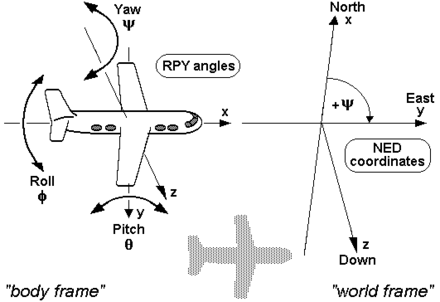3.3 KiB
Reference Frames
Many reference frames are used throughout. This folder contains all helper functions needed to transform between them. Generally this is done by generating a rotation matrix and multiplying.
Orientation Conventations
Quaternions, rotation matrices and euler angles are three equivalent representations of orientation and all three are used throughout the code base.
For euler angles the preferred convention is [roll, pitch, yaw] which corresponds to rotations around the [x, y, z] axes. All euler angles should always be in radians or radians/s unless for plotting or display purposes. For quaternions the hamilton notations is preferred which is [qw, qx, qy, qz]. All quaternions should always be normalized with a strictly positive qw. These quaternions are a unique representation of orientation whereas euler angles or rotation matrices are not.
To rotate from one frame into another with euler angles the convention is to rotate around roll, then pitch and then yaw, while rotating around the rotated axes, not the original axes.
Calibration
EONs are not all mounted in the exact same way. To compensate for the effects of this the vision model takes in an image that is "calibrated". This means the image is aligned so the direction of travel of the car when it is going straight and the road is flat is always in the location on the image. This calibration is defined by a pitch and yaw angle that describe the direction of travel vector in device frame.
Example
To transform global Mesh3D positions and orientations (positions_ecef, quats_ecef) into the local frame described by the first position and orientation from Mesh3D one would do:
ecef_from_local = rot_from_quat(quats_ecef[0])
local_from_ecef = ecef_from_local.T
positions_local = np.einsum('ij,kj->ki', local_from_ecef, postions_ecef - positions_ecef[0])
rotations_global = rot_from_quat(quats_ecef)
rotations_local = np.einsum('ij,kjl->kil', local_from_ecef, rotations_global)
eulers_local = euler_from_rot(rotations_local)

